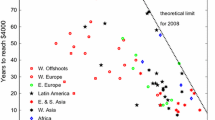Abstract
A model of development is studied in which physical capital and unskilled labor are good substitutes, and skilled labor is complementary to the resulting aggregate. Growth in a closed economy is compared with two open regimes. Inflows of physical capital only reduce the interest rate and raise both wage rates. The skilled wage rises more sharply, however, increasing the skill premium and accelerating human capital accumulation. Full integration with a larger and more developed neighbor also reduces the interest rate and raises both wage rates, but in this case the skill premium falls and human capital accumulation changes very little.
Similar content being viewed by others
References
Baldwin, R. E. (1971). “Determinants of the Commodity Structure of U.S. Trade,” American Economic Review 61, 126–46.
Barro, R. J., and J.-W. Lee. (1993). “International Comparisons of Educational Attainment,” Journal of Monetary Economics 32, 363–394.
Branson, W. H., and H. B. Junz. (1971). “Trends in U.S. Trade and Comparative Advantage,” Brookings Papers on Economic Activity, 285–338.
Davis, S. J. (1992). “Cross-Country Patterns of Change in Relative Wages.” In NBER Macroeconomics Annual, Vol. 7. Cambridge: MIT Press.
Elias, V. J. (1992). Sources of Growth: A Study of Seven Latin American Economies. San Francisco: ICS Press.
Findlay, R., and H. Kierzkowski. (1983). “International Trade and Human Capital: A Simple General Equilibrium Model,” Journal of Political Economy 91, 957–978.
Galor, O., and D. N. Weil. (1996). “The Gender Gap, Fertility, and Growth,” American Economic Review 86, 374–387.
Goldin, C., and L. F. Katz. (1996). “Technology, Skill, and the Wage Structure: Insights from the Past,” American Economic Review, Papers and Proceedings 86, 252–257.
Griliches, Z. (1969). “Capital-Skill Complementarity,” Review of Economics and Statistics 51, 465–468.
Haley, W. J. (1976). “Estimation of the Earnings Profile from Optimal Human Capital Accumulation,” Econometrica 44, 1223–1238.
Hammermesh, D. S. (1986). “The Demand for Labor in the Long Run.” In Orley Ashenfelter and R. Layard (eds), The Handbook of Labor Economics, Vol. I. Amsterdam: North-Holland.
Heckman, J. J. (1975). “Estimates of a Human Capital Production Function Embedded in a Life-Cycle Model of Labor Supply.” In Nestor E. Terleckyi (ed), Household Production and Consumption. New York: Columbia University Press.
Keesing, D. B. (1966). “Labor Skills and Comparative Advantage,” American Economic Review: Papers and Proceedings 55, 249–258.
Keesing, D. B. (1971). “Different Countries' Labor Skill Coefficients and the Skill Intensity of International Trade Flows,” Journal of International Economics 1, 443–452.
Kehoe, T. J. (1994). “Towards a Dynamic General Equilibrium Model of North American Trade.” In Joseph F. Francois and Clinton R. Shiells (eds), Modeling Trade Policy: Applied General Equilibrium Assessments of NAFTA. Cambridge, U.K.: Cambridge University Press.
Kim, D. I., and R. Topel. (1992). “Labor Markets and Economic Growth: Lessons from Korea's Industrialization, 1970–1990,” working paper, University of Chicago.
Krusell, P., et al. (1996). “Capital-Skill Complementarity and Inequality,” working paper, University of Rochester.
Kwark, N.-S., and C. Rhee. (1992). “Educational Wage Differentials in Korea,” working paper, University of Rochester.
Leamer, E. (1984). Sources of International Comparative Advantage. Cambridge, MA: MIT Press.
Londono de la Cuesta, J. L. (1990). “Income Distribution During the Structural Transformation: Columbia 1938–1988.” Ph.D. dissertation, Harvard University.
Lucas, R. E. Jr. (1988). “On the Mechanics of Economic Development,” Journal of Monetary Economics 22, 3–42.
Mincer, J. (1974). Schooling, Experience, and Learning. New York: Columbia University Press.
Mulligan, C. B. (1992). “Computing Transitional Dynamics in Recursive Growth Models: The Method of Progressive Paths,” working paper, University of Chicago.
Murphy, K. M., and F. Welch. (1992). “The Structure of Wages,” Quarterly Journal of Economics 107, 285–326.
Psacharopoulos, G., and Y. C. Ng. (1994). “Earnings and Education in Latin America,” Education Economics 2, 187–207.
Stokey, N. L., and S. Rebelo. (1995). “Growth Effects of Flat Rate Taxes,” Journal of Political Economy 103, 519–550.
Summers, R., and A. Heston. (1991). “The Penn World Table (Mark 5): An Expanded Set of International Comparisons, 1950–1988,” Quarterly Journal of Economics 106, 327–368.
Waehrer, H. (1968). “Wage Rates, Labor Skills, and United States Foreign Trade,” In Peter B. Kenen and Roger Lawrence (eds), The Open Economy: Essays on International Trade and Finance. New York: Columbia University Press.
World Bank. (1991). World Development Report.
Author information
Authors and Affiliations
Rights and permissions
About this article
Cite this article
Stokey, N.L. Free trade, factor returns, and factor accumulation. J Econ Growth 1, 421–447 (1996). https://doi.org/10.1007/BF00150196
Issue Date:
DOI: https://doi.org/10.1007/BF00150196




